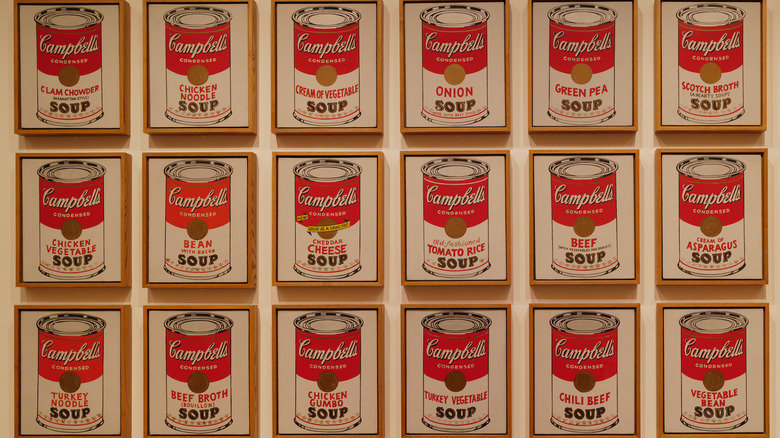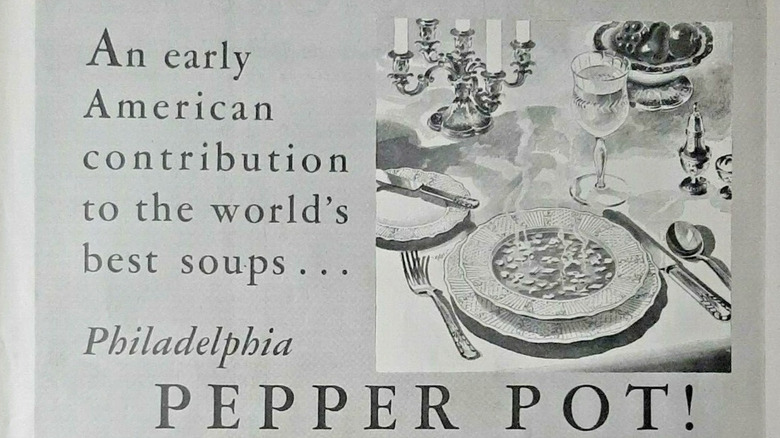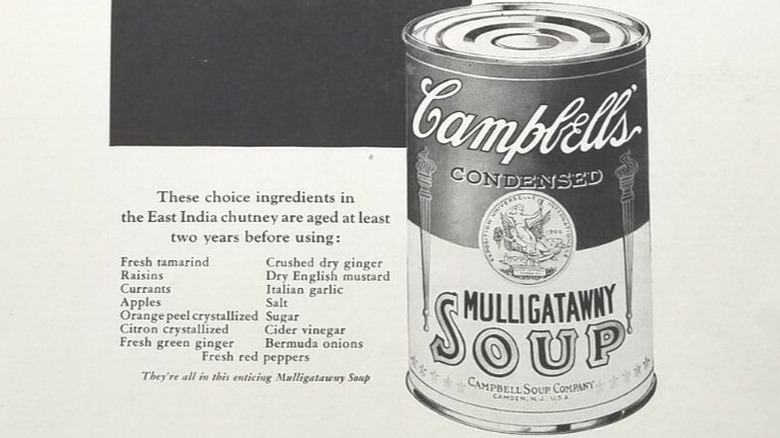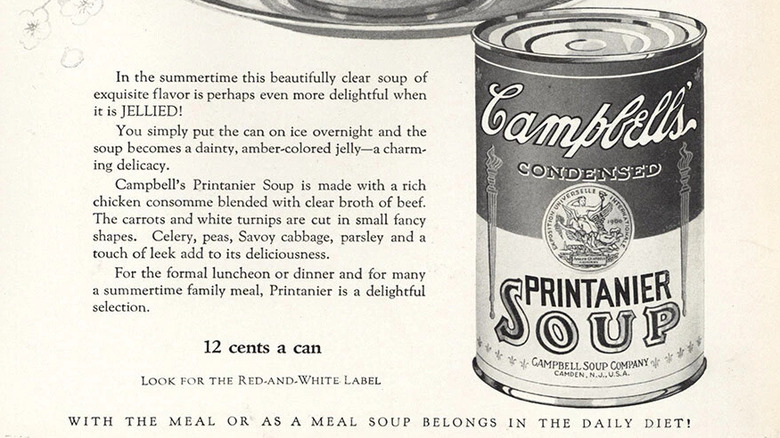4 Old-School Campbell's Soups Everyone Forgot About
We may receive a commission on purchases made from links.
Campbell's is a legendary brand of canned soups that revolutionized the industry when it debuted the world's first condensed soup in 1897. With a reduction in can size and weight, it was suddenly cheaper than ever to make, transport, and sell this grocery staple, which soon ballooned into dozens of different soup varieties. But in the company's 100-plus-year history, some once-popular varieties have fallen into obscurity.
Some of these forgotten flavors were marketed toward higher-brow clientele, even as condensed canned soups. Campbell's once offered a Mock Turtle Soup to ride the coattails of real turtle soup, which was popular with the upper class but difficult for anyone to get in areas that didn't have a lot of turtles. Another former offering, Printanier Soup, used a French word for "springlike" to describe the delicate mix of beef broth, chicken consomme, and young vegetables.
Some forgotten parts of Campbell's lineup also reflected the racial diversity of America. Mulligatawny soup was one such product, born initially from British culture and mixed with Indian cuisine during the subcontinent's colonial era. And Campbell's Pepper Pot soup spoke to the rich African-American culinary tradition, canning a dish that originally came to the United States via slave trading from West Africa and the Caribbean.
Campbell's mock turtle soup
To modern consumers, something called mock turtle soup might raise eyebrows, but from the early 1900s onward, this was a major part of Campbell's line of soups. Turtle soup is one of the old-school soups that you rarely find today, but about 100 years ago, it was considered a delicacy.
The availability of turtle soup was, however, limited by the availability of turtles. Geographically, turtles didn't have a ubiquitous spread, but more critically, the demand for real turtle meat nearly drove key species to extinction. Mock turtle soup used the head and offal of much more common, affordable animals — cows — to approximate the taste and texture of turtle soup. And over time, it became more popular than the real thing.
Mock turtle soup became less popular with Americans after the end of World War II, and by 1960, Campbell's canned variety had disappeared completely. But real turtle soup can still be found on a few old-school restaurant menus, including Commander's Palace in New Orleans, where it's considered a staple dish.
Campbell's pepper pot soup
Campbell's Pepper Pot Soup is perhaps the oldest entry on this list, appearing in the company's soup lineup as early as 1899, just two years after it first debuted condensed soups. This soup, featuring whole black peppercorns and beef tripe, has a remarkably old and varied history.
Pepper Pot soup has its origins in West Africa, where it first came to the Caribbean due to the slave trade. Caribbean islands were a common source for American enslavers to buy humans in bondage, and this is how Pepper Pot soup arrived in the United States, specifically, Philadelphia, where the soup was prevalent among the colonial-era Black population.
Campbell's featured Pepper Pot in its soup lineup for over 100 years. It was a noted favorite of pop artist Andy Warhol, who even screenprinted it in 1968 among his other famous Campbell's works. But in 2010, this canned variety became one of the many discontinued store-bought soups, and the Campbell's version lost what little cultural cache it had remaining.
Campbell's mulligatawny soup
Mulligatawny soup is a rare sight in the present-day United States, but about a century ago, it was part of the regular Campbell's soup lineup. The dish originated during the British colonial rule of India, and eventually became a common item on American store shelves, too.
British colonial officials expected a soup course before the main dish, but Indian chefs were accustomed to serving an entire meal, family-style, all at once, not individual plates in multiple courses. So they improvised a mixture of broth, curry, and vegetables that proved quite popular with British eaters. By 1905, Campbell's had its own canned version.
While the variety's exact lifespan is not known, it was around for at least 25 years. One of the last chronological appearances of the can is in a 1934 Campbell's ad, which compared it to an Asian chicken soup with curry and chutney. Unfortunately, the nearly century-old advertisement used language that today is considered dated, if not racist — one facet of this canned soup that we're glad is gone for good.
Campbell's printanier soup
Campbell's Printanier Soup is a true ghost of Campbell's past. Not much is known about it, though it appeared in advertisements in 1905. "Printanier" is a French word that denotes something as spring-like, and in a culinary context, it means a dish made with diced spring vegetables. In this soup, the vegetables were mixed with clear beef broth and chicken consommé for a bowl that Campbell's said worked with almost any meal.
Unusual among the soups on this list, Campbell's Printanier was sometimes served as a brownish jelly instead of a liquid soup, just by chilling it overnight. Regardless of its preparation, Printanier's popularity as a Campbell's soup eventually faded. It appeared in Campbell's advertisements in 1934, but is difficult to publicly trace after that.
Perhaps the closest successor to this long-gone Campbell's variety is its classic vegetable soup, containing chopped veggies in beef broth — but none of the chicken consommé that helped define the original. Unfortunately, Campbell's Vegetable Soup is not worth the trouble, and tastes overwhelmingly of potatoes and salt. People chasing the experience of Campbell's Printanier Soup are better off making their own from scratch.




